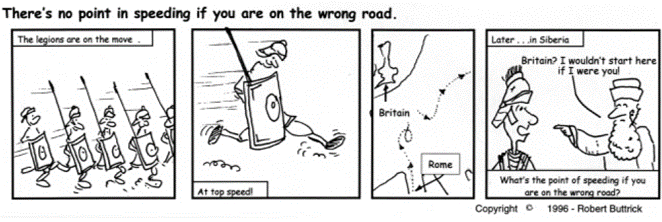First published in Project Manager Today magazine
Robert Buttrick’s second article, drawn from his best selling book, The Project Workout, takes us back to the fundamentals of business-led project management, looking at why we need a staged approach to managing projects.
Use the same, simple, and well-defined framework with a staged approach for all projects in all circumstances
A staged approach to project management is now the norm. In fact, a staged approach for projects is vital both in terms of risk management and effective control.
Rarely is it possible to plan a project in its entirety from start to finish; there are simply too many unknowns. By using defined project stages, it is possible to plan for the next stage in detail and the remaining stages in summary. As you progress through the project, from stage a stage, your endpoint becomes clearer and your confidence in delivering increases.
Further, as projects impact on all functions and all parts of the company, most companies are now striving to make their project stages consistent for all types of project. They also strive to make them as simple as possible. This makes the use and understanding of what is often called a ‘project framework’, very much easier and avoids the need for learning different terminology and processes for different types of project.
This is particularly helpful to senior management who sponsor projects as they do not have to learn a different jargon for each aspect or type of project they are directing. By having one basic framework they are able to understand their role within it and do not have to learn a new language for each situation. What differs is the work content of each project, the level of activity, the nature of activity, the resources required and the stakeholders who need to be engaged.
A common criticism is that a staged approach to projects slows things down. ‘Why can’t we just get on and do it!’ is often the cry. Those companies that have investigated this deeper have found that a staged approach actually speeds up desirable projects. It is only the less well-planned or undesirable projects which tend to get held up. That’s no consolation to those managing such projects but it is surely better to slow down undesirable projects or terminate them, than to allow them to continue to consume resource which the company simply cannot afford to waste.

The points between stages are often called ‘Gates’. Most commonly these are seen as exit or ‘end’ points of one stage, prior to starting the next. However, I like to think of gates as entry points to a stage. By looking at them as such, it is possible to overlap stages without increasing risk or breaking any arbitrary rules. It is far more important to be ready to continue with work on the next stage of a project than to have finished absolutely everything on a previous stage.
In the relentless drive for speed people often ask. ‘Where is the fast track?’ Those companies who have reached a degree of maturity know there is no fast track. It is simply not possible to achieve the objectives by skipping unnecessary work or going ahead without planning ahead. Such an approach usually increases the risks beyond an acceptable level and eventually slows down the delivery date. ‘Fast tracking’ should be concerned more with setting priorities on projects, ensuring those with the greatest leverage are allocated resources first.
Pause for thought … the blockers to achieving project excellence
Dash in and get on with it!
Don’t confuse ‘activity’ with ‘action’. If a project is that important and the timescales are that tight, you really haven’t got the time NOT to plan your way ahead. Falling for this trap will inevitably build in failure to deliver and higher
operational costs for your business. Instead, look at how you can phase the project so some benefits can be realised early. Be realistic.

Analysis paralysis
You need to investigate and plan, but only enough to give you the confidence to move forward. Projects are risky and decisions will need to be made with imperfect information with ‘eyes wide open’. This is the opposite of ‘Dash in and get on with it’ so don’t use it as an excuse to delay essential and achievable projects indefinitely.
e-Projects are different!
Yes e-Projects are different. They tend to move faster, be more complex and be less visible and therefore you have the scope to create a really big mess in super quick time! All the principles of project management in this series of articles are even more valid in the e- Environment than the traditional environment: speed and complexity need a greater level of management attention and skill.
Read the third article in this series
© Robert Buttrick





